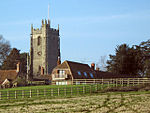Agapemonites

The Agapemonites or Community of The Son of Man was a Christian religious group or sect that existed in England from 1846 to 1956. It was named from the Greek: agapemone meaning "abode of love". The Agapemone community was founded by the Reverend Henry Prince in Spaxton, Somerset. The sect also built a church in Upper Clapton, London, and briefly had bases in Stoke-by-Clare in Suffolk, Brighton and Weymouth. The ideas of the community were based on the theories of various German religious mystics and its primary object was the spiritualisation of the matrimonial state. The Church of England had dismissed Prince earlier in his career for his radical teachings. The Agapemonites predicted the imminent return of Jesus Christ. According to newspaper accounts, Prince's successor, John Hugh Smyth-Pigott, declared himself Jesus Christ's reincarnation. The Agapemone community consisted mostly of wealthy unmarried women. Both Prince and Smyth-Pigott took many spiritual brides. Later investigations have shown that these "brides" were not solely spiritual and that some produced illegitimate children. In 1860, Prince lost a lawsuit brought on behalf of Louisa Nottidge by the Nottidge family and the group vanished from the public eye. It finally closed in 1956 when the last member died.
Excerpt from the Wikipedia article Agapemonites (License: CC BY-SA 3.0, Authors, Images).Agapemonites
Charlynch Road,
Geographical coordinates (GPS) Address Nearby Places Show on map
Geographical coordinates (GPS)
| Latitude | Longitude |
|---|---|
| N 51.1279 ° | E -3.0972 ° |
Address
Charlynch Road
Charlynch Road
TA5 1BJ
England, United Kingdom
Open on Google Maps










